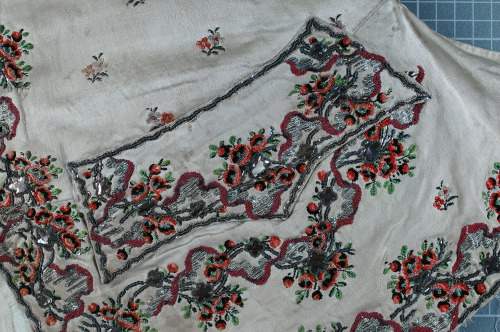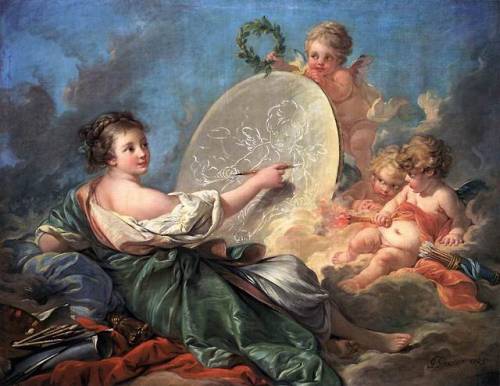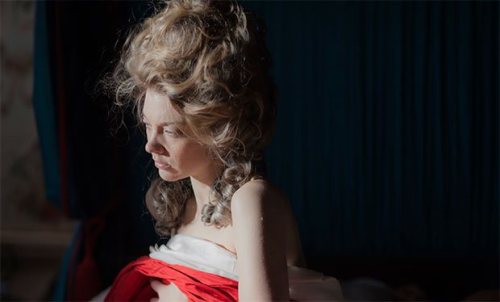#18th century
A group of six handcolored plates of insects and flowers, 1763 by Moses Harris (English, 1731–1785)
Post link
Death Of Hector (Achilles Dragging The Body Of Hector) by Gavin Hamilton (Scottish, 1723–1798)
Post link
Men’s waistcoat, c1768-72
White satin embroidered flowers and floral border, red brown green and silver thread.
This waistcoat has been shortened as the pocket flap covers part of the background embroidery. It was very common to reuse such expensive fabric as this eighteenth century hand-embroidered silk.
Post link







My samples are here and I’ve got some new patterns up! I’m splitting them into 3 separate posts.
The first one I drew is this black & white crinoid fossil pattern copied from a 1760’s teapot from The Met’s collection. The Milwaukee Art Museum has a nearly identical one, also 1760’s, and at first I’d assumed they were heavily stylized but it turns out that slices of crinoidal limestone really do look like that. (source for the last picture) Looking at pictures of crinoid fossils I found matches for almost every single motif in the teapot, and was amazed.
I drew my pattern with a smallish felt tipped pen and did the dots in between with a sharpie. This is the first historical pattern I’ve ever copied (not from fabric, but it’s still a historical pattern) and I doubt anyone would ever guess it was 18th century.
It’s on Spoonflower,MyFabricDesigns, and Redbubble.






I finished a thing! This 1780’s ship printed waistcoat fabric was a birthday gift last year and it’s been sitting half finished in The Pile since last winter, but is done now.
The fabric is from Summer sun stories, with the exception of the button covers, which I painted to be more like the ones on the original waistcoat and to fit my tiny button moulds. I should also note that I tea dyed the fabric to make the white less bright.
It’s partly hand sewn and partly machine sewn, and I’m really happy with the fit! The only problem is that the shoulders are a bit wrinkled, especially the right one, which is lower than my left shoulder and causes wrinkling in all my collared waistcoats. I added a bit of padding to that side, which helped to smooth it out.
(I look kind of sad in these photos but it’s just because I was tired when I took them.)








(No, I don’t know how to play the violin.) I made a new shirt! It’s a style I’ve wanted to try for quite a while, where there are no buttons and the collar closes with a ribbon through 2 buttonholes.
This kind of shirt appears in quite a few early 18th century portraits, and some mid century ones, though those later ones are more often children’s shirts. I have a section for all the ones I’ve found on my shirts pinterest board.
I’d originally planed to do some machine seams, but the linen was so nice I ended up sewing the whole thing by hand. And of course I had to try and re-create Young Man With A Violin by Jan Kupecký, c. 1706, from the Museum of Fine Arts, Budapest.
I also got some other pictures of it worn with a waistcoat, and with a different ribbon, which I’ll post later.



A couple years ago I tried making 18th century metallic buttonholes with embroidery plate wrapped around strips of vellum, which worked and produced a result that looked just like some pictures of extant ones I’ve seen, but I never got around to using them on a garment. Recently I realized that in the 21st century we have metallic leather, and that using strips of that would be quicker and much less expensive, so I tried it and it worked very well!
I bought a couple of metallic leather samples off etsy and used a rotary cutter to make narrow strips. I cut and overcast the holes as usual, then just sewed down the little strips to the edges with a widely spaced buttonhole stitch using a regular fine metallic thread, and did bar tacks at the ends. It’s a bit annoying doing little bar tacks with metallic thread, but much less annoying than wrapping vellum in plate!
One of my samples is in a blueish silvery colour, which isn’t very historical but looks quite nice, and the other is a duller gold with a somewhat pebbled texture. I don’t like it quite as much as the shinier one, but I think it could still work really well, depending on the fabric.
Hopefully I’ll do some of these on an actual garment sometime this year.

A horn cup, love token, with a whaling scene, dated 1793
Inscribed with: […] Remember Me Though Many Leagues We Distance Be




Francesco Queirolo, Santa Rosalia (1756), Museo Cappella Sansevero,Napoli.


Carlo Amalfi,Ritratto di Vincenzo di Sangro (1770-80), Museo Cappella Sansevero, Napoli.


Francesco De Mura, Ritratto di Raimondo di Sangro (1745-55), particolari, Sacrestia, Museo Cappella Sansevero, Napoli.




- Francesco Maria Russo,Tomba di Raimondo di Sangro(1759)
- Carlo Amalfi,Ritratto di Raimondo di Sangro(1759-60)
Museo Cappella Sansevero, Napoli.



Francesco Celebrano(?),Monumento a Giovan Francesco di Sangro, quinto principe di Sansevero (1756),Museo Cappella Sansevero, Napoli.



Antonio Corradini (?), Monumento a Giovan Francesco di Sangro, terzo principe di Sansevero (1752),Museo Cappella Sansevero, Napoli.








